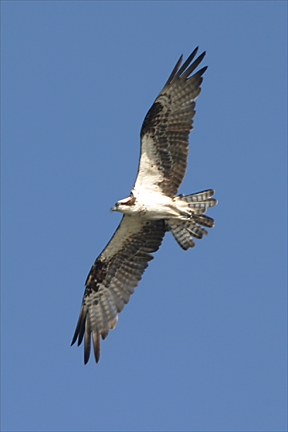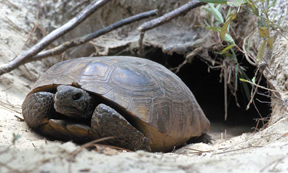|
History Animals & Plants Rare & Endangered Invasive Exotics Human Use |
Animals and Plants: Rare, Threatened, and Endangered Species
 The osprey's population has fluctuated in different states since 1966, according to bird count data (photo by Karla Brandt) |
Why are rare species rare?
This question has many answers. In fact, it has a different answer for nearly every rare plant or animal. Some were once abundant but are now uncommon. Others were always scarce, and still others are rare in some parts of their ranges and common in others. Rarity may be caused by humans, either directly or indirectly, or it may have nothing to do with human activities.
Some species are hunted, fished, or collected until there are no more. A classic example is the Carolina parakeet, a pretty green bird who lived in hardwood forests and bottomlands throughout the Southeast. Although other factors were probably involved in its extinction, shooting no doubt played a major part in its last act. Farmers killed it because it damaged crops, hunters killed it to sell its feathers to hat-makers, and sportsmen killed it because it was an easy target. When one bird was killed, the others in the flock would come to it. Florida was probably its last stronghold. The last known Carolina parakeet died in 1918.
Loss of habitat is probably the biggest threat these days. Some species cannot survive without a particular kind of habitat or particular conditions in their habitat. For example, shorebirds (including snowy plover, Wilson's plover, American oystercatcher, and least tern) require undisturbed sandy beaches for nesting. In Florida, with its fast-growing human population, such beaches are becoming increasingly rare. More examples: invasive plants like the popcorn tree can outcompete native plants; urban development eliminates food plants and denning habitat needed by animals such as the Florida black bear; water pollution destroys habitat needed by aquatic species like the Apalachicola floater (a mussel) and the shoal bass.
Some species that are rare in north Florida are more common in other states to the north or west of Florida. An example is the purple coneflower, which is found throughout the Southeast from the Ozarks to Virginia, but is listed as endangered in Florida because only a few populations occur here.
A species may be abundant now but its future doesn't look promising for survival, often because of several factors at work at the same time. For example, habitat destruction, a low rate of reproduction, and disease combine to make the outlook bleak for the gopher tortoise. These animals must be at least a dozen years old before they are old enough to reproduce, and the number of baby tortoises that live long enough to lay eggs of their own is thought to be very small. Their well-drained upland habitat is perfect for housing developments, and gopher tortoises can't survive on lawn grass. Finally, gopher tortoises suffer from a contagious disease called Upper Respiratory Tract Disease that makes it risky to relocate tortoises that are in the path of development. The Florida Fish and Wildlife Conservation Commission has strict requirements for permits for relocating gopher tortoises.
 The gopher tortoise has no federal protection in Florida, but it is federally listed as threatened in Louisiana, Mississippi, and western Alabama. The State of Florida lists the gopher tortoise as a Species of Special Concern (FNAI) (photo by Dan Hipes) |
Legal definitions
Not all rare plants and animals are legally protected. The Florida Natural Areas Inventory (FNAI) keeps track of about 500 kinds of rare animals, and most of them do not have any legal protection. FNAI tracks nearly the same number of plant species and subspecies, and the State of Florida considers almost all of them to be either Threatened or Endangered. (These terms are explained below.)
Laws, and the regulations adopted by agencies to carry them out, tend to be complicated, like life itself (which is what laws and rules must deal with). For rare species, there are two levels: federal and state. At each level, there are different rules for plants and for animals, as well as different lists of species covered by those rules. In the lingo, a species that appears on one of these lists is referred to as a “listed” species.
One more layer: federal and state rules have different categories. At present, federal categories are Threatened and Endangered. One Florida species, the American alligator, is federally listed under a third category: Threatened by Similarity of Appearance. It looks so much like one or more other federally listed species that it's very difficult for enforcement officers to tell them apart, particularly once they've been made into shoes or suitcases.
Florida rules also classify species and Threatened or Endangered, and they add a third category: Species of Special Concern.
Just when you thought you understood the system, surprise! There's another twist. The definitions of “Threatened” and “Endangered” in state law are different from those in federal law. One thing that is consistent between the levels is that Endangered is a more precarious situation than Threatened.
The federal Endangered Species Act (ESA) was passed by the U.S. Congress in 1973 to protect species of plants and animals that are in danger of disappearing. Under the ESA, plants and animals currently facing extinction are classified as Endangered. Declining species that may disappear in the near future, for which the risk of extinction is real but less imminent, are classified as Threatened.
The State of Florida defines as Endangered those naturally occurring animal species “whose prospects of survival are in jeopardy” due to destruction of habitat, excessive exploitation, or other natural or human causes. An animal species may be designated as Threatened if it may “become endangered if it is subjected to increased stress as a result of further modification of its environment” ( Florida Statutes, Chapter 372.072). The criteria for listing an animal as a Species of Special Concern are more complicated, but many of the species in this category are likely to become Threatened unless they are protected or managed (see Florida Administrative Code 68A-27.005).
A native plant species is considered Endangered in Florida if it is classified as either Threatened or Endangered under the federal Endangered Species Act. Any plant species not federally protected may be listed as Endangered by the State of Florida if it is “in imminent danger of extinction within the state” and Threatened if its numbers are in “rapid decline” but not yet so low as to be Endangered (Florida Statutes, Chapter 581.185).
So, you ask, how do species get on the lists, and why are they sometimes taken off? That is a long story, and probably one best asked of your local Fish and Wildlife Service (federal) or Florida Fish and Wildlife Conservation Commission (state) officials.
Note: The content of the website has not been updated since 2005. The site remains online for it's value as legacy content and is unlikely to be updated.